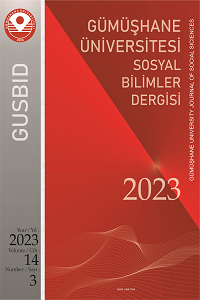Abstract
The main contribution of this research lies in identifying a crucial insight: the slow growth of new firms in local economies may be attributed to a self-sustaining mechanism characterized by volatile influx of new firms. In other words, regions with lower long-term entry rates exhibit higher relative volatility in this aspect. A similar argument can be made for exit rates as well. To categorize spatial units in economics, Machine Learning algorithms can be utilized. In this study, Turkish cities were clustered based on firm dynamics data spanning from 2009 to 2020. Through the implementation of an Unsupervised Learning (k-means) algorithm, four clusters were identified based on entry rates, while six clusters were identified based on exit rates. This approach represents an improvement over traditional methods that often require extensive manual effort to incorporate numerous socioeconomic variables into a criterion. Furthermore, it helps reduce subjectivity inherent in such methods, which heavily rely on qualitative analyses. The proposed method empowers policymakers to obtain groupings that align with their economic objectives and foster policy success.
References
- Acar, S., Kazancık, L. B., Meydan, M. C., & Işık, M. (2019). İllerin ve Bölgelerin Sosyo-Ekonomik Gelişmişlik Sıralaması Araştırması SEGE-2017. Kalkınma Ajansları Genel Müdürlüğü Yayını, (3).
- Arcuri, G., Brunetto, M., & Levratto, N. (2019). Spatial Patterns and Determinants of Firm Exit: An Empirical Analysis on France. The Annals of Regional Science, 62(1), 99-118. https://doi.org/10.1007/S00168-018-0887-0
- Armington, C., & Acs, Z. J. (2002). The determinants of regional variation in new firm formation. Regional studies, 36(1), 33-45.
- Athey, S. (2019). The Impact of Machine Learning on Economics. A. Agrawal, J. Gans, & A. Goldfarb (Eds.) The Economics of Artificial Intelligence: An Agenda (507-547). University of Chicago Press. Https://Doi.Org/10.7208/9780226613475-023
- Athey, S., & Imbens, G. W. (2019). Machine Learning Methods That Economists Should Know About. Annual Review of Economics, (11), 685-725. https://Doi.Org/10.1146/Annurev-Economics-080217-053433
- Audretsch, D. B., & Fritsch, M. (1994). The geography of firm births in Germany. Regional studies, 28(4), 359-365.
- Barboza, F., Kimura, H., & Altman, E. (2017). Machine Learning Models and Bankruptcy Prediction. Expert Systems with Applications, (83), 405-417. https://Doi.Org/10.1016/J.Eswa.2017.04.006
- Bargagli-Stoffi F.J., Niederreiter J., Riccaboni M. (2021) Supervised Learning for The Prediction of Firm Dynamics. In: Consoli S., Reforgiato Recupero D., Saisana M. (Eds) Data Science for Economics and Finance. Springer, Cham. https://Doi.Org/10.1007/978-3-030-66891-4_2
Abstract
Bu çalışmanın en önemli bulgusu çok önemli bir anlayışı tanımlama üzerinedir: yerel ekonomilerde yavaş yeni firma oluşumu, istikrarsız yeni firma girişleri açısından olası bir kendi kendini sürdürebilir mekanizma ile birliktedir. Başka bir deyişle, uzun vadede girişlerin az olduğu yerel ekonomiler, bu istatistik açısından daha fazla göreli dalgalanma yaşarlar. Aynı argüman çıkışlar için de geçerlidir. Ekonomide mekansal birimlerin sınıflandırılması, Makine Öğrenimi algoritmaları kullanılarak yapılabilir. Bu çalışmada, 2009-2020 yılları arasındaki firma dinamikleri verileri kullanılarak Türk şehirleri kümelendirilmiştir. Bir Denetimsiz Öğrenme (k-means) algoritması uygulanmasıyla, giriş temelli olarak dört ve çıkış temelli olarak altı küme belirlenmiştir. Önerilen model, birçok sosyoekonomik değişkeni bir kriterde birleştirme konusunda önemli çaba gerektiren geleneksel yöntemlere kıyasla bir iyileşme olarak görülebilir. Ayrıca, nitel analizlere yoğun şekilde dayanan bu tür yöntemlerin öznel olma halini azaltmaya yardımcı olabilir. Önerilen yöntem sayesinde, politika yapıcılar ekonomik hedeflerine uygun gruplamalar elde edebilir ve politikaların başarısını artırabilir.
References
- Acar, S., Kazancık, L. B., Meydan, M. C., & Işık, M. (2019). İllerin ve Bölgelerin Sosyo-Ekonomik Gelişmişlik Sıralaması Araştırması SEGE-2017. Kalkınma Ajansları Genel Müdürlüğü Yayını, (3).
- Arcuri, G., Brunetto, M., & Levratto, N. (2019). Spatial Patterns and Determinants of Firm Exit: An Empirical Analysis on France. The Annals of Regional Science, 62(1), 99-118. https://doi.org/10.1007/S00168-018-0887-0
- Armington, C., & Acs, Z. J. (2002). The determinants of regional variation in new firm formation. Regional studies, 36(1), 33-45.
- Athey, S. (2019). The Impact of Machine Learning on Economics. A. Agrawal, J. Gans, & A. Goldfarb (Eds.) The Economics of Artificial Intelligence: An Agenda (507-547). University of Chicago Press. Https://Doi.Org/10.7208/9780226613475-023
- Athey, S., & Imbens, G. W. (2019). Machine Learning Methods That Economists Should Know About. Annual Review of Economics, (11), 685-725. https://Doi.Org/10.1146/Annurev-Economics-080217-053433
- Audretsch, D. B., & Fritsch, M. (1994). The geography of firm births in Germany. Regional studies, 28(4), 359-365.
- Barboza, F., Kimura, H., & Altman, E. (2017). Machine Learning Models and Bankruptcy Prediction. Expert Systems with Applications, (83), 405-417. https://Doi.Org/10.1016/J.Eswa.2017.04.006
- Bargagli-Stoffi F.J., Niederreiter J., Riccaboni M. (2021) Supervised Learning for The Prediction of Firm Dynamics. In: Consoli S., Reforgiato Recupero D., Saisana M. (Eds) Data Science for Economics and Finance. Springer, Cham. https://Doi.Org/10.1007/978-3-030-66891-4_2
Details
| Primary Language | English |
|---|---|
| Subjects | Applied Microeconometrics, Regional Economy, Industrial Economy |
| Journal Section | Articles |
| Authors | |
| Publication Date | October 9, 2023 |
| Submission Date | July 8, 2023 |
| Published in Issue | Year 2023 Volume: 14 Issue: 3 |



